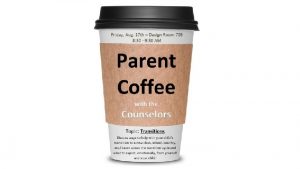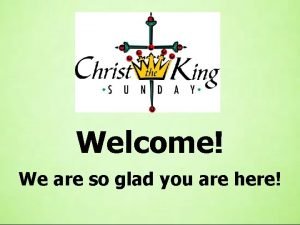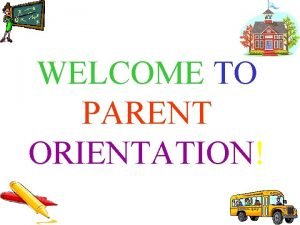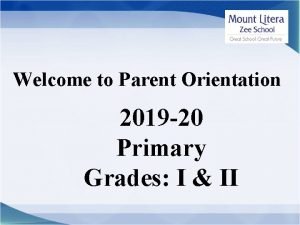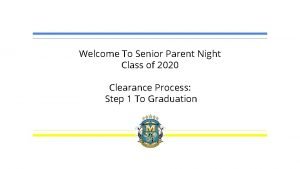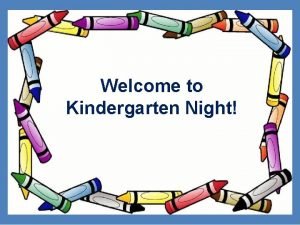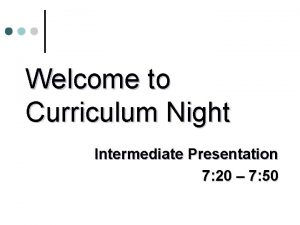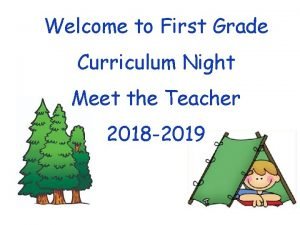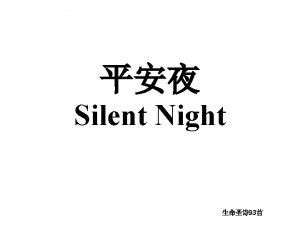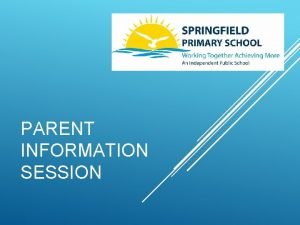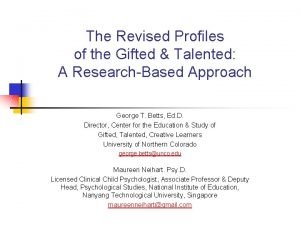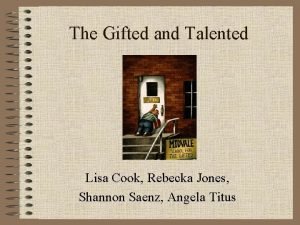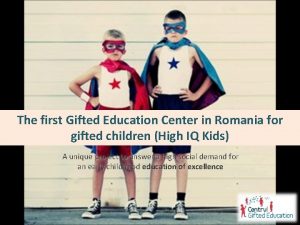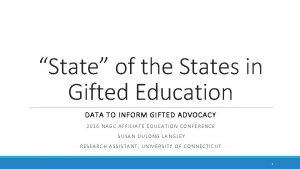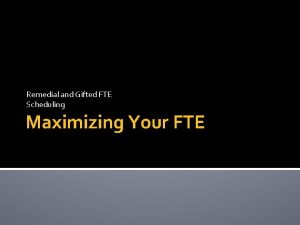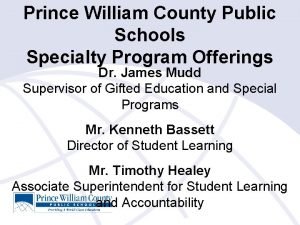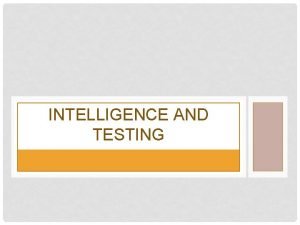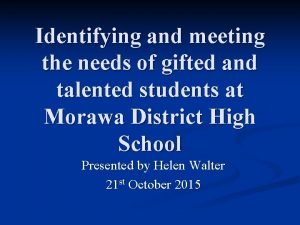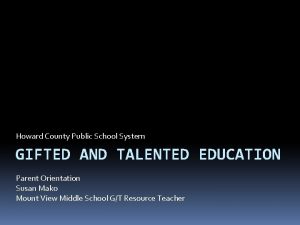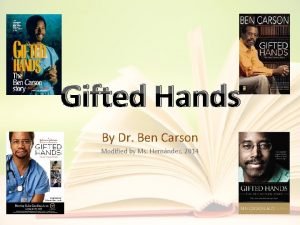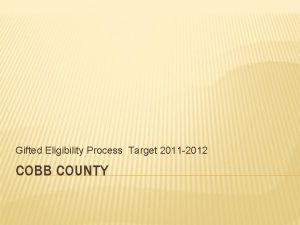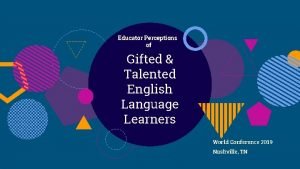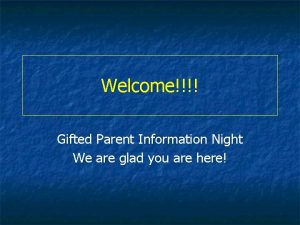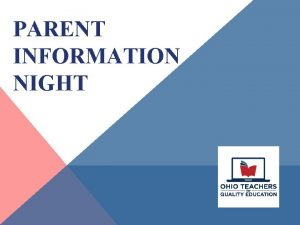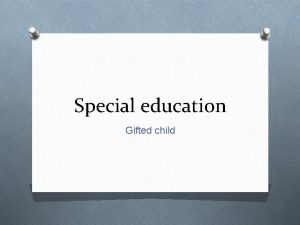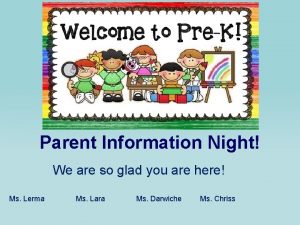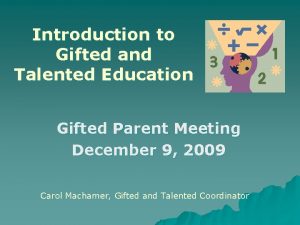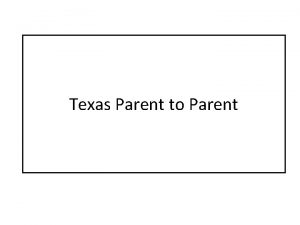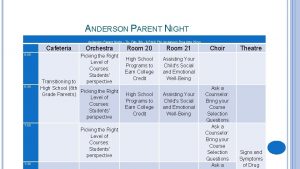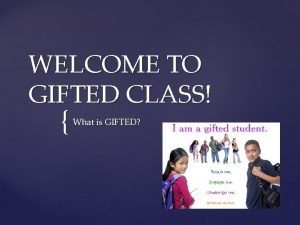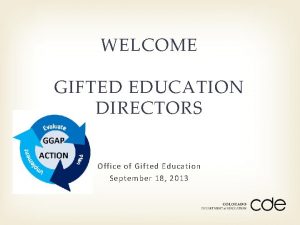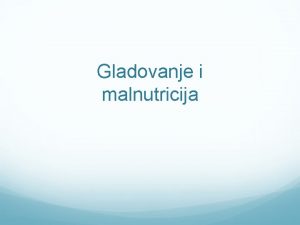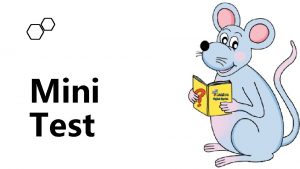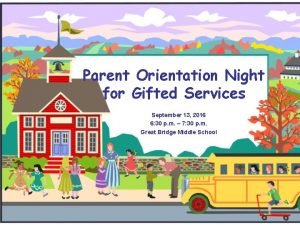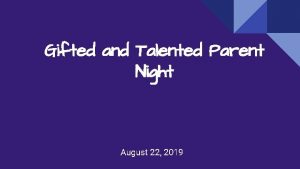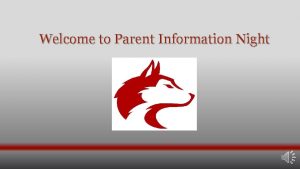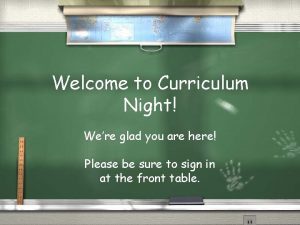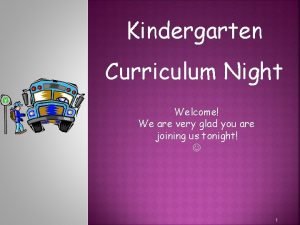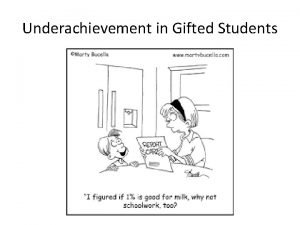Welcome Gifted Parent Information Night We are glad
















































- Slides: 48

Welcome!!!! Gifted Parent Information Night We are glad you are here!

Jacqui Greene Resource Teacher for the Gifted Carlos Ramirez Principal Cheryl Mc. Cullough, Supervisor of Gifted Services

Welcome! ■ Please jot down any questions during the presentation. ■ If I cannot address your question during the presentation, I will follow up: ■ ■ please include your name your child’s name (if applicable) your contact information the best time for me to reach you.

Learning Outcomes • • • Explain the role of the Resource Teacher for the Gifted (RTG) within a Professional Learning Community (PLC). Provide an overview of gifted services at Randolph ES. Provide an overview of the identification process for Gifted Services in Arlington Public Schools.

Virginia Gifted Regulations – APS Local Plan 2017 - 2021 Virginia Department of Education regulations state that each school district must develop a plan to identify and provide services to those students who have learning needs beyond the regular instructional program. https: //www. apsva. us/wpcontent/uploads/2015/04/2017 -2022 -Gifted. Services-Local-Plan. pdf

Shared Responsibility for Daily Differentiation for Gifted Learners Cluster Teacher Collaboration with RTG Curriculum for Gifted Learners

Role of the RTG • Promote and model procedures, strategies, and techniques to support gifted students • • Work collaboratively with cluster teachers to plan and deliver instruction Provide curricular resources in order to differentiate content for gifted students • • • Lead PD and/or inform staff about gifted education training opportunities Advocate for underrepresented populations to include 2 e, ESOL/HILT, children from poverty Facilitate the gifted identification process

Professional Learning, CLT’s, Modeling, Co-Teaching

RTGs as Advocates for Historically Underserved Populations Twice Exceptional (2 e) ■ English Learners ■ High Ability, Low Income Students ■ Underachieving Students ■

Gifted Services in K-5 classrooms

Differentiation for Gifted Students Differentiation Strategy What it looks like in the classroom General Examples Specific Examples - critical and creative thinking strategies -use of curriculum designed for high ability learners -integrating lessons and activities from Project M 3: Factors, Multiples and Leftovers as a way for high ability learners to learn GCF and LCM Process Providing students with different ways to interact with content Product Providing options for -choice board demonstrating their learning -tic-tac-toe menu learning contracts Content typically is -extending the grade 5 order of differentiated when a student -extension of content operations standard to include has already mastered grade -project based parentheses and exponents level standards for a learning particular unit or topic. To show an understanding of the different regions of Virginia students can create a project of their choice (ie: artwork, piece of writing, performance, etc. )

Collaborative Teaching ■ Collaborative Teaching may involve: ■ ■ Whole group team teaching with classroom teacher Small group teaching in classroom, coordinated and co-planned with classroom teacher Co-planning with classroom teacher to support differentiation on days when gifted resource teacher is not in the classroom Flexible grouping, which may be determined by ■ Needs of students and/or the classroom teacher ■ Difficulty of unit/topic

Collaboration


Advanced-Content Resources ■ ■ ■ ■ William and Mary Literature Units Junior Great Books/Socratic Seminar Jacob’s Ladder Reading Comprehension Program Schoolwide Enrichment Model -Reading (SEM-R) Framework Project M 2 and Project M 3 Best of the Continental Math League APS Grade 5/6 Math Curriculum ■ ■ ■ ■ Hands-On Equations Project Clarion Science Units William and Mary Problem. Based Science Units William and Mary Social Studies Units History Alive! The DBQ Project Primary Source Documents (Library of Congress) Socratic Seminar

Classroom Support (K-1) Collaboratively plan Critical and Creative Thinking (CCT) lessons ■ Model and deliver monthly CCT lessons ■ Build capacity for teachers to replicate similar lessons in the future ■ Provide support for differentiating instruction ■ Working with teachers to find and nurture underrepresented populations ■

CCT in Kindergarten Critical and Creative Teaching Strategy: FOFE

Big Ideas and Bloom’s Taxonomy Critical and Creative Teaching Strategy: Concept of Patterns

Planning with Teachers Collaborative Book Studies: Mindset in the Classroom

Classroom Support (2 -5) ■ ■ ■ Collaborate with grade-level teams to plan and/or implement advanced content Utilize collaborative teaching methods in cluster classrooms Incorporate CCT skills to build capacity of teachers to replicate similar lessons in the future Provide support for differentiating instruction Working with teachers to find and nurture underrepresented populations

Planning and Co-Teaching Advanced Content: Math M 3 Project

The Mystery of the Moli Stone

Mindmapping: Making Those Connections!

Building Language

Leading Whole Group Lessons Critical and Creative Thinking for All: Applying GEMAS to Riddles and Multistep Mathematics Problems

Leading Small Group Lessons Advanced Content: Hands On Equations

Modeling of CCT Strategies Critical and Creative Thinking: Fluency, Flexibility, Originality and Elaboration (FFOE)

Communication ■ Differentiation Record Form- quarterly report to parents for identified students in grades K-5 ■ Parent information nights (Fall and Spring) ■ Conferences ■ Ongoing collaboration between RTG-classroom-home

Gifted Services Advisory Committee (GSAC) Arlington Public School’s Parent Advocacy Group Part of Advisory Council of Instruction https: //www. apsva. us/aci/gifted-services/ Monthly meetings If interested in serving on this committee, please contact Dan Corcoran, danjcorcoraniii@gmail. com

Contact Information Jacqui Greene , RTG Email: jacqui. greene@apsva. us Phone: 703 -228 -5830 @Randolph. Equity Cheryl Mc. Cullough, Supervisor, Gifted Services Email: cheryl. mccullough@apsva. us Phone: 703 -228 -6159

Parent Resources ■ ■ ■ Virginia Association for the Gifted (VAG) http: //www. vagifted. org National Association for the Gifted (NAGC) http: //nagc. org Supporting Emotional Needs of the Gifted (SENG) http: //sengifted. org

Screening

Part 3: The Gifted Identification Process

Gifted Services: Areas of Identification ■ Specific Academic Aptitude (Grades K-12) ■ ■ ■ English Mathematics Science Social Studies Visual or Performing Arts (Grades 3 -12) ■ ■ Visual Art General Music

Screening for Gifted Services • • • Each year, the total population is screened by school staff to create a pool of candidates based on students’ need for gifted services. Students may be referred for services by their classroom teacher, school personnel, parents/guardians, community leaders, or other students until April 1 st of the current school year Once a student is referred for services, the RTG works to create a portfolio with four main components for a holistic case study approach.

1. Nationally-normed assessments ■ ■ ■ Grade 2 students, and new-to-APS 3 rd graders, take the Naglieri Nonverbal Ability Test (NNAT-2) Grade 4 students, and new-to-APS 5 th graders, take the Cognitive Abilities Test (Cog. AT) Other tests may be included such as the WISC, Kaufman-Brief Intelligence Test (KBIT)

2. School-based Achievement ■ ■ ■ County Level: SOLs and other available data School Level: Ongoing formative and summative assessments Individual Level: Honors or distinctions

3. Student Behaviors/Characteristics ■ Local screening committee completes a Gifted Behavior Commentary (GBC) ■ Documents gifted characteristics and behaviors observed in a variety of settings across four categories Parent Information Sheet ■ ■ Documents gifted characteristics and behaviors observed in a variety of settings across four categories Provides an opportunity for parents to share examples that the school team may not have had an opportunity to observe during the school day

Gifted Behaviors Commentary (GBC) Exceptional ability to learn Exceptional application of knowledge • • • Is highly reflective and/or sensitive to his/her environment Readily learns and adapts to new cultures Is acquiring language at a rapid pace • Uses and interprets advanced symbol systems in academics, visual arts, and/or performing arts • Acts as an interpreter, translator, and/or facilitator to help others • Communicates learned concepts through role playing and/or detailed artwork Exceptional creative / productive thinking • Expresses ideas, feelings, experiences, and/or beliefs in original ways • Perceives and manipulates patterns, colors, and/or symbols Exceptional motivation to succeed • Meets exceptional personal and/or academic challenges • Exhibits a strong sense of loyalty and responsibility • Demonstrates exceptional ability to adapt to new experiences

4. Demonstrated Performance ■ Distinguished levels of performances when working with advanced content. Examples may include: Project M 2 & Project M 3 ■ Interpretive responses within William and Mary Language Arts units ■ Analysis of Primary Source Documents ■ Responses to Critical and Creative Thinking lessons ■

Visual and Performing Arts (VPA) ■ Referrals for Visual/Performing Arts begin in Grade 3 ■ ■ Art and Music Teacher Observations of Artistic Behaviors Student Products provided by art/music teachers Grades Parent Information Form

Art Differentiation ■ Visual Arts: ■ Differentiation takes place in the art classroom ■ ■ ■ analyzing their work with more in-depth questions working with more/different materials Open-ended projects that allow for students to demonstrate their creativity and abilities

Music Differentiation ■ Vocal Music: ■ Differentiation takes place in the music classroom ■ Open-ended projects that allow for students to demonstrate their creativity and abilities

Identification Decisions • • At the end of the referral process (90 instructional days), a local screening committee meets to review the student’s portfolio and make determines about eligibility. Identification decisions are sent to parents or guardians by letter within 10 school days of the Identification Committee meeting. Gifted Services Identification Process Outlined on APS Gifted Services web page

If students are found eligible • • Identified gifted students in grades 2 -5 are cluster grouped* into classrooms with intellectual peers *typically or the upcoming school year RTG plans with and supports the classroom teachers using extension activities and projects for students who have already mastered gradelevel content • Note: Support may look different in the various grade levels depending on teacher and student needs

If students are not found eligible ■ An appeal is available to families following the eligibility process ■ Appeals begin at the school level with the principal ■ A second level of appeal is countywide Gifted Services Administrative Appeals Committee http: //www. apsva. us/Page/1846#appeal

Parent Resources ■ ■ ■ Virginia Association for the Gifted (VAG) http: //www. vagifted. org National Association for the Gifted (NAGC) http: //nagc. org Supporting Emotional Needs of the Gifted (SENG) http: //sengifted. org

? Questions ?
 Mikael ferm
Mikael ferm Welcome we're glad you're here
Welcome we're glad you're here Welcome were glad you are here
Welcome were glad you are here So glad you joined us
So glad you joined us We are glad you joined us
We are glad you joined us Welcome to the team we're glad you're here
Welcome to the team we're glad you're here Welcome glad you are here
Welcome glad you are here Welcome so glad you are here
Welcome so glad you are here Welcome we are glad you are here
Welcome we are glad you are here We are glad you are here
We are glad you are here Welcome we are so glad you are here
Welcome we are so glad you are here Welcome we are so glad you are here
Welcome we are so glad you are here Welcome we're glad you're here
Welcome we're glad you're here Welcome so glad you are here
Welcome so glad you are here Welcome we are glad you are here
Welcome we are glad you are here Welcome we are glad you are here
Welcome we are glad you are here Welcome glad you are here
Welcome glad you are here Welcome we're so glad you're here
Welcome we're so glad you're here Welcome we're glad you joined us
Welcome we're glad you joined us Welcome so glad you're here
Welcome so glad you're here First presbyterian church logo
First presbyterian church logo We are glad you are here welcome song lyrics
We are glad you are here welcome song lyrics In the morning glad i see
In the morning glad i see Welcome to parent orientation
Welcome to parent orientation Welcome to parent orientation
Welcome to parent orientation Welcome speech for kindergarten parent orientation
Welcome speech for kindergarten parent orientation Senior parent night
Senior parent night Fsa parent night flyer
Fsa parent night flyer Welcome welcome this is our christmas story
Welcome welcome this is our christmas story Welcome to kindergarten night
Welcome to kindergarten night Welcome to curriculum night
Welcome to curriculum night Welcome to curriculum night
Welcome to curriculum night Fire in night by elie wiesel
Fire in night by elie wiesel Silent night holy night all is calm
Silent night holy night all is calm Parent information session
Parent information session Gifted child anger problems
Gifted child anger problems Maureen neihart keynote revised profiles of the gifted
Maureen neihart keynote revised profiles of the gifted Gifted vs talented
Gifted vs talented Gifted education
Gifted education Nagc state of the states
Nagc state of the states What is fte
What is fte Woodbridge high school specialty programs
Woodbridge high school specialty programs Deped gifted and talented program
Deped gifted and talented program The flynn effect
The flynn effect Neihart and betts 2010
Neihart and betts 2010 Howard county gifted and talented
Howard county gifted and talented Gifted hands chapter 1 summary
Gifted hands chapter 1 summary Cobb county gifted program
Cobb county gifted program Midvale school for the gifted
Midvale school for the gifted





